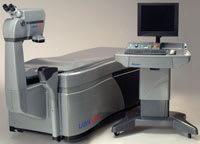spotlight on technology &
technique
The
LADAR6000 Excimer Laser
By Leslie Goldberg, Assistant Editor
The LADAR6000 excimer laser precisely removes targeted tissue and reshapes the cornea, providing patients with a custom LASIK procedure, says Alcon. The LADAR6000 has a multitude of new features including an improved microscope, new software and a more ergonomic workstation.
Stephen F. Brint, M.D., of Brint Custom Vision and associate professor of ophthalmology at Tulane University School of Medicine, used Alcon's Autonomous, which then became the LADAR 4000. He has since upgraded to the LADAR6000.
"The single biggest improvement in this instrument, in my opinion, is the fact that the laser has 80% new components. This laser is more dependable, has a better TUI laser cavity, which should deliver even more stability and predictability and needs gas changes less frequently. Perhaps of equal importance, is the 50% increased speed of ablation, which also should increase predictability of correction, reducing the hydration factor," says Dr. Brint.
|
|
|
Alcon's LADAR6000 excimer laser and workstation. |
Advances in the LADAR6000
The following advances have been made to the LADAR6000:
■ Auto-Registration. Registration helps ensure correct customized ablation positioning. Automation of this capability at the LADARWave aberrometer saves time and increases consistency. Automation enhances the capture, match, treat process.
In a study conducted by Eric Donnenfeld, M.D., on technician efficiency using the LADAR system, it was found that different technicians had considerably different results in both time and accuracy when manually registering the wavefront measurement to the patient's eye. It was then determined than in order to improve patient flow and accuracy, this process should be automated. The auto-registration feature of the LADARWave was able to match the accuracy of registration of Dr. Donnenfeld's most accurate technician, but seven times faster, simplifying customized treatments for patients.
Auto-registration includes one-click accuracy confirmation. After taking the centration image, the limbal and pupil reticles snap into place for quick, accurate ring placement.
"While the registration process currently uses the limbus and two spots that the surgeon applies at the 3 and 9 o'clock position, it will soon be replaced with scleral blood vessel recognition," says Dr. Brint. "This allows the surgeon to eliminate the mark placement, but more importantly, the LadarWave image can be obtained anytime prior to surgery, even days before. Then on surgery days, this step is already done and the LadarWave data is transferred to the laser and accurately registered to the ablation, allowing more accuracy as well as saving valuable time on surgery days."
Ronald Krueger, M.D., MSE, of the department of refractive surgery, Cole Eye Institute, The Cleveland Clinic Foundation, says of the upgrades, "The autoregistration feature and LADARWave centration image allows for increased accuracy and the infrared illumination sets up the possibility for upgrades using scleral vessel tracking and registration."
■
Enhanced Illumination.
An automated and optimized lighting array incorporates infrared and white light
offering consistency and ease-of-use. Infrared illumination reduces the need for
white light allowing for greater patient comfort. Infrared lighting also enhances
pupil and iris detail so surgeons can easily verify accurate registration on darker
irises. Soft white "ring light" is used for general illumination, facilitating patient
comfort and localization of the fixation target. Off-axis lights increase visibility
of landmarks on the eye. The LADAR6000 produces a variety of intelligent, task-specific
lighting ranges throughout the procedure for increased consistency.
"Multiple illumination methods, including a white ring light, white side lights and infrared lights, allow the surgeon to see well when using a microkeratome, or when lifting a flap. You can then turn the lights down, allowing better patient fixation on the fixation light while still seeing the eye well in the laser display screen or any other monitor using the infrared illumination," says Dr. Brint.
■ Increased Speed. A reduction in procedure time provides increased efficiency and convenience for the doctor, staff and patient. The LADAR6000 has a decreased ablation time, especially effective in higher ranges. There is significantly less corneal bed exposure time and an improved effluent removal system with this upgrade. Intuitive software guides the surgeon through each step of the procedure. This prompting makes surgery faster and more consistent, reducing potential variability throughout the custom LASIK process.
■ Software. "The new LADAR6000 software allows the LadarWave image and the surgical image to be displayed simultaneously, allowing the surgeon to see that the eyes match and see how much cyclorotation has occurred. It also prompts the laser technician as to what the next step should be, which is great for new technicians. Additionally, the system prompts you to do the steps in the correct order, potentially avoiding any errors," says Dr. Brint.
■ Ergonomic Workstation. The newly designed workstation provides users with greater flexibility and comfort. A flat-screen monitor with retractable arm and high resolution is part of the system, along with a high-resolution digital video recording system.
For more information on the LADAR6000, visit their Web site at www.ladarvision.com.









